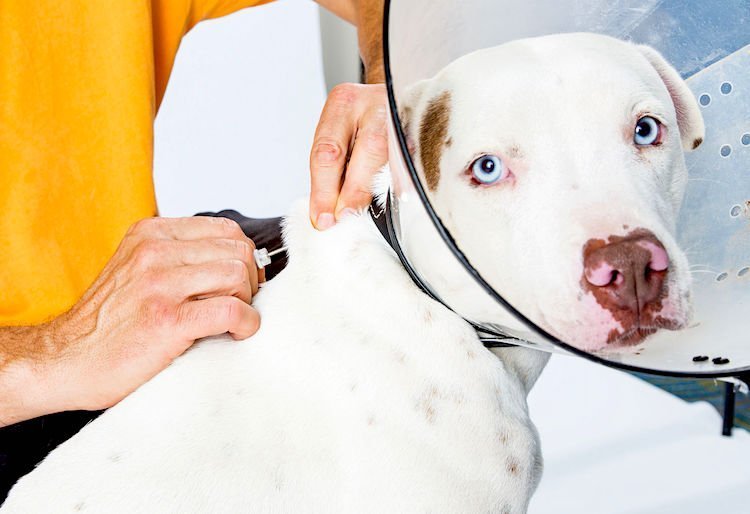What’s the best thing you can do for your cat who might wander off? Microchip.
Of course, all dogs should be microchipped, too. But most veterinarians see a lot more missing cats than dogs. We’ve been able to reunite quite a lot of them with their families.
Microchipping is a simple and economical insurance policy.
Anyone who has sat in an empty home, staring out a window, hoping to see their lost pet show up can identify with that horrible feeling of guilt and sadness:
Is Buffy dead or alive? Was she hit by a car? Lost in the woods? Is she lying hurt by the side of a highway?
Word that Buffy has been recovered because of her microchip is — well, there are no words. Pure relief, jubilation and an outpouring of gratitude describe the feeling of being united with a lost pet. That’s the power of a pet microchip.
How Does a Pet Microchip Work?
A pet microchip is a tiny device about the size of a grain of rice. Contained within glass that’s designed to be placed in your pet’s body, the microchip holds a small computer chip.
The microchip is implanted between your pet’s shoulder blades with a needle.
This computer chip stores your contact information. Most animal shelters and vet offices have scanners that can read pet microchips, and they will routinely scan any animal found or brought in.
Do I Need a Microchip?
Any pet is capable of venturing too far out because of curiosity, chasing another animal or being stolen.
It takes just a second for this to happen, and soon you’ll be scrambling to drive the streets, call neighbors and post flyers.
These methods can help recover a lost pet, but what happens if the person who finds your dog or cat hasn’t seen your flyer? Most people will bring the animal to the nearest shelter or vet’s office in the hopes that you can be found.
Collars can slip off or be removed, leaving no way of identifying the pet as yours. If the pet had a microchip that could be scanned, the vet or shelter will find you much faster.
With that said, according to the American Veterinary Medical Association (AVMA), “Microchips are great for permanent identification that is tamper-proof, but nothing replaces a collar with up-to-date identification tags when it comes to quickly identifying a found pet.”
Will a Microchip Hurt My Pet?
The process of installing the microchip is similar to your dog or cat getting a shot.
The needle is a little bigger, but the pain is minimal and the process is usually quick.
Anesthesia is not needed, so this can be done at your vet’s office.
Check out this quick video about how pet microchips work, then we’ll discuss microchip benefits:
Benefits of Microchipping Your Dog or Cat
- Fast and easy implant done with a needle in your vet’s office.
- No anesthesia needed.
- Minimal pain, similar to a shot.
- Helps locate families of lost pets, avoids your lost pet getting adopted or euthanized.
- Affordable cost: $25–$55.
- Most implants last around 25 years and usually won’t need to be replaced or updated.
- Peace of mind and closure. Animals that are found, even if deceased, are scanned for a microchip so their families can be notified.
- Professionals with scanners are trained to scan the entire body in case the microchip has migrated elsewhere. This is uncommon, and the chip usually doesn’t migrate far from the shoulder area, but they check all over to be sure.
- Universally used as a method of identification in multiple countries, which can be a benefit to those who travel with their pets.
- Natural disasters, such as hurricanes or tornadoes, can cause a lot of animals to be lost unexpectedly. Having a microchip can help rescue professionals find you faster instead of placing your dog in a shelter or foster care.
What Pet Microchips Don’t Do
- Microchips are not tracking devices. There is no GPS or locator.
- They are useful only if scanned.
- Not all places will have scanners or universal scanners.
Do-It-Yourself Microchipping?
We don’t recommend using home kits for microchip implantation.
Why? Because the contents can be ineffective, or you could have trouble implanting the device yourself. This can make the process difficult for you and painful for your pet.
Also, when you allow a vet to implant the chip:
- The vet will scan the microchip after implementation to ensure it works. That’s a huge plus.
- If something goes wrong, you’ll always know whom to turn to for assistance.
- Most home kits cost about the same as having a professional perform the implantation, so you won’t save any money.

Do Pet Microchips Cause Cancer?
There’s a myth going around that microchips cause cancer in dogs and cats.
Proponents of natural and holistic animal health care are usually the folks behind the sensational stories about pet microchips causing cancer.
We would like to set the record straight. Microchips are safe.
As of June 2017, there was evidence of a mere 2 tumors at the site of a microchip out of the millions of pets microchipped in the United States, and just 2 tumors in 3.7 million pets in the United Kingdom over a 13-year-long span.
All in all, the risk of a pet microchip causing tumors at the site of implantation is very, very small.
Where the Cancer Myth Began
In the early 2000s, multiple studies involving laboratory mice or rats found that microchips caused foreign body–induced tumors in less than 1% of the rodents.
These mice and rats were already being used in cancer studies, so they were not a random, genetically varied population.
The researchers cautioned that this shouldn’t be used as evidence that microchips cause tumors in dogs, cats or humans. But people grabbed on to it anyway and went down the road of alternative fact-mongering.
In 2007, ABC news reported the mice story because Alzheimer’s patients were beginning to be microchipped.
Based on the rodent studies, the U.S. Food and Drug Administration felt that more research should be done before claiming microchips are completely benign in humans.
ABC added a quote from a cancer researcher saying he would not put one of those things (microchip) in his pet, sensationalizing the story quite a bit.

Microchips: A Great Safety Record
It has been more than a decade since these laboratory animal studies and the ABC news coverage.
And in those years, millions more cats and dogs have been microchipped with very little reason for concern.
In 2013, the AVMA published its opinion of microchips, saying they are safe and documenting only 2 cases of skin tumors related to microchips: 1 in a dog and 1 in a cat.
The AVMA put it this way: “Mice and rats are more susceptible than other species to developing foreign body-induced tumors; therefore, extrapolation of increased incidences of foreign body-induced tumors in mice to increased risk in other species, including humans, is inappropriate.”
Dr. Andy Roark, DVM, reckons the chances of a pet microchip causing cancer are around 1 in 1.85 million.
Therefore, the risk is “incredibly tiny,” he says. Even so, he frets that “it’s that extremely small window of uncertainty that people propagating sensationalistic click-bait online exploit.”
“I’ve seen the terror-inducing headlines and the harm [these sensational stories] do to pets that end up lost without a microchip because of them,” Dr. Roark says: “’Pet owners duped!’ ‘MICROCHIPS CAUSE CANCER!’ etc.”
“Those headlines drive me nuts, because they deter people from doing something that could very well save their pet’s life.”
Risks vs. Benefits of a Pet Microchip
So, no, pet microchips are not 100% safe. But evidence shows that tumors caused by microchips are an extremely rare occurrence.
Weigh that against the importance microchips play in recovering lost pets, and it’s a no-brainer.
Ask your vet: They’ve probably reunited multiple lost pets with their humans because they found a microchip implanted in the animals.
Unless you have an insurance policy from the great beyond that your dog or cat is never going to run out of an open door or jump a fence or wander beyond safe territory, we encourage you to consider a pet microchip.
If your pet is precious to you, your 12 mm microchip is worth 12 million times its weight in gold.

What Else You Can Do
While the benefits of getting your dog or cat microchipped certainly outweigh the shortcomings, there are other steps you can take to help ensure your pet is returned to you if lost:
- Make sure your pet always has a collar and tag. Metal tags work better than plastic tags — they don’t chip or break, the information doesn’t wear off as easily, and they usually last longer.
- Don’t allow your pet to roam.
- Use responsible boarders or sitters if your pet can’t be with you.
If you microchip your dog or cat, ask to see and verify your contact information that is put into the computer or written down to send to the microchip company.
Keep your copy of this paperwork with your vaccination records and current photos of your dog for easy retrieval.
Final Thoughts on Pet Microchips
If a tragic end has come to your pet and you find out about it, you might feel inconsolable, sad — all those desperate emotions. But at least you know what happened.
When you’re faced with a missing pet, the unknown factor can be the most nightmarish of all. There’s no closure. At 4 a.m., you just keep wondering if you hear them outside. Then you become despondent all over again.
So, please get your pets microchipped for that extra help if they go missing.
It’s not an end-all-be-all solution. But if we can have a happy ending every once in a while, it’s worth it.
References
+ Click to see the sources for this article.
 This pet health content was written by a team of writers including a veterinarian, Dr. Debora Lichtenberg, VMD. It was reviewed for accuracy by Dr. Pippa Elliott, BVMS, MRCVS, and was last updated May 1, 2020.
This pet health content was written by a team of writers including a veterinarian, Dr. Debora Lichtenberg, VMD. It was reviewed for accuracy by Dr. Pippa Elliott, BVMS, MRCVS, and was last updated May 1, 2020.


